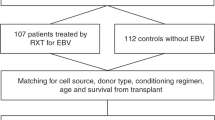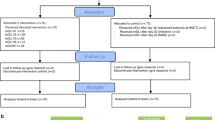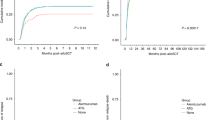Abstract
Treatment with rituximab is highly effective for EBV-associated post transplant lymphoproliferative disease. However, little is known about its immunological sequelae in pediatric allogeneic hematopoietic SCT (HSCT). Time to normal CD19+ B-lymphocyte values in blood and intravenous immunoglobulin (IVIG) substitution needed to maintain an IgG>400 mg per 100 ml in six consecutive pediatric allogeneic HSCT patients treated with rituximab for symptomatic EBV reactivation were compared with a matched cohort of non-rituximab-treated patients. Follow-up of the six patients ranged from 149 to 1546 days; all but one survived. The mean (±s.d.) time to recovery of CD19+ B-lymphocytes was 353±142 days as compared with 139±42 in the controls (P<0.01). Similarly, substitution of IVIG as a measure of functional B-cell recovery was extended from a mean of 122±45 to a mean of 647±320 days, and the cumulative dose of IVIG increased from a mean of 1.86±0.51 to 4.4±0.97 g/kg, respectively (P<0.05). One patient had functional B-lymphocyte deficiency for >3 years and ultimately required two stem cell boosts. Rituximab is a live-saving treatment for pediatric HSCT patients but may lead to prolonged and even persistent B-cell deficiency.
This is a preview of subscription content, access via your institution
Access options
Subscribe to this journal
Receive 12 print issues and online access
$259.00 per year
only $21.58 per issue
Buy this article
- Purchase on Springer Link
- Instant access to full article PDF
Prices may be subject to local taxes which are calculated during checkout

Similar content being viewed by others
References
Curtis RE, Travis LB, Rowlings PA, Socie G, Kingma DW, Banks PM et al. Risk of lymphoproliferative disorders after bone marrow transplantation: a multi-institutional study. Blood 1999; 94: 2208–2216.
Faye A, Vilmer E . Post-transplant lymphoproliferative disorder in children: incidence, prognosis, and treatment options. Paediatr Drugs 2005; 7: 55–65.
Svoboda J, Kotloff R, Tsai DE . Management of patients with post-transplant lymphoproliferative disorder: the role of rituximab. Transpl Int 2006; 19: 259–269.
Reff ME, Carner K, Chambers KS, Chinn PC, Leonard JE, Raab R et al. Depletion of B cells in vivo by a chimeric mouse human monoclonal antibody to CD20. Blood 1994; 83: 435–445.
Tedder TF, Engel P . CD20: a regulator of cell-cycle progression of B lymphocytes. Immunol Today 1994; 15: 450–454.
Milpied N, Vasseur B, Parquet N, Garnier JL, Antoine C, Quartier P et al. Humanized anti-CD20 monoclonal antibody (rituximab) in post transplant B-lymphoproliferative disorder: a retrospective analysis on 32 patients. Ann Oncol 2000; 11 (Suppl 1): 113–116.
Faye A, Quartier P, Reguerre Y, Lutz P, Carret AS, Dehée A et al. Chimaeric anti-CD20 monoclonal antibody (rituximab) in post-transplant B-lymphoproliferative disorder following stem cell transplantation in children. Br J Haematol 2001; 115: 112–118.
van Esser JW, Niesters HG, van der Holt B, Meijer E, Osterhaus AD, Gratama JW et al. Prevention of Epstein-Barr virus-lymphoproliferative disease by molecular monitoring and preemptive rituximab in high-risk patients after allogeneic stem cell transplantation. Blood 2002; 99: 4364–4369.
Messahel B, Taj MM, Hobson R, Hadzic N, Ramsay A, Hann I et al. Single agent efficacy of rituximab in childhood immunosuppression related lymphoproliferative disease: a United Kingdom Children's Cancer Study Group (UKCCSG) retrospective review. Leuk Lymphoma 2006; 47: 2584–2589.
Weinstock DM, Ambrossi GG, Brennan C, Kiehn TE, Jakubowski A . Preemptive diagnosis and treatment of Epstein-Barr virus-associated post transplant lymphoproliferative disorder after hematopoietic stem cell transplant: an approach in development. Bone Marrow Transplant 2006; 37: 539–546.
Maloney DG, Grillo-Lopez AJ, White CA, Bodkin D, Schilder RJ, Neidhart JA et al. IDEC-C2B8 (rituximab) anti-CD20 monoclonal antibody therapy in patients with relapsed low-grade non-Hodgkin's lymphoma. Blood 1997; 90: 2188–2195.
McLaughlin P, Grillo-López AJ, Link BK, Levy R, Czuczman MS, Williams ME et al. Rituximab chimeric anti-CD20 monoclonal antibody therapy for relapsed indolent lymphoma: half of patients respond to a four-dose treatment program. J Clin Oncol 1998; 16: 2825–2833.
Harris NL, Ferry JA, Swerdlow SH . Posttransplant lymphoproliferative disorders: summary of Society for Hematopathology Workshop. Semin Diagn Pathol. 1997; 14: 8–14.
Bouquillon C, Dewilde A, Andreoletti L, Lambert V, Chieux V, Gerard Y et al. Simultaneous detection of 6 human herpesviruses in cerebrospinal fluid and aqueous fluid by a single PCR using stair primers. J Med Virol 2000; 62: 349–353.
Mackay IM . Real-time PCR in the microbiology laboratory. Clin Microbiol Infect 2004; 10: 190–212.
Ruiz G, Peña P, de Ory F, Echevarría JE . Comparison of commercial real-time PCR assays for quantification of Epstein-Barr virus DNA. J Clin Microbiol 2005; 43: 2053–2057.
Choquet S, Leblond V, Herbrecht R, Socie G, Stoppa AM, Vandenberghe P et al. Efficacy and safety of rituximab in B-cell post-transplantation lymphoproliferative disorders: results of a prospective multicenter phase 2 study. Blood 2006; 107: 3053–3057.
Comans-Bitter WM, de Groot R, van den Beemd R, Neijens HJ, Hop WC, Groeneveld K et al. Immunophenotyping of blood lymphocytes in childhood. Reference values for lymphocyte subpopulations. J Pediatr 1997; 130: 388–393.
Kliegman RN, Behrman RF, Jenson HR (eds.) Nelson Textbook of Pediatrics, chapter 710, 17th edn. WB Saundern: Philadelphia, PA, 2003.
Nishio M, Fujimoto K, Yamamoto S, Endo T, Sakai T, Obara M et al. Hypogamma-globulinemia with a selective delayed recovery in memory B cells and an impaired isotype expression after rituximab administration as an adjuvant to autologous stem cell transplantation for non-Hodgkin lymphoma. Eur J Haematol 2006; 77: 226–232.
Nishio M, Fujimoto K, Yamamoto S, Endo T, Sakai T, Obara M et al. Delayed redistribution of CD27, CD40 and CD80 positive B cells and the impaired in vitro immunoglobulin production in patients with non-Hodgkin lymphoma after rituximab treatment as an adjuvant to autologous stem cell transplantation. Br J Haematol 2007; 137: 349–354.
Shortt J, Spencer A . Adjuvant rituximab causes prolonged hypogammaglobulinaemia following autologous stem cell transplant for non-Hodgkin's lymphoma. Bone Marrow Transplant 2006; 38: 433–436.
Lim SH, Zhang Y, Wang Z, Esler WV, Beggs D, Pruitt B et al. Maintenance rituximab after autologous stem cell transplant for high-risk B-cell lymphoma induces prolonged and severe hypogammaglobulinemia. Bone Marrow Transplant 2005; 35: 207–208.
Sidner RA, Book BK, Agarwal A, Bearden CM, Vieira CA, Pescovitz MD . In vivo human B-cell subset recovery after in vivo depletion with rituximab, anti-human CD20 monoclonal antibody. Hum Antibodies 2004; 13: 55–62.
Anolik JH, Friedberg JW, Zheng B, Barnard J, Owen T, Cushing E et al. B cell reconstitution after rituximab treatment of lymphoma recapitulates B cell ontogeny. Clin Immunol 2007; 122: 139–145.
Dunleavy K, Hakim F, Kim HK, Janik JE, Grant N, Nakayama T et al. B-cell recovery following rituximab-based therapy is associated with perturbations in stromal derived factor-1 and granulocyte homeostasis. Blood 2005; 106: 795–802.
Arber C, Buser A, Heim D, Weisser M, Tyndall A, Tichelli A et al. Septic polyarthritis with ureaplasma urealyticum in a patient with prolonged agammaglobulinemia and B-cell aplasia after allogeneic HSCT and rituximab pretreatment. Bone Marrow Transplant 2007; 40: 597–598.
Imashuku S, Teramura T, Morimoto A, Naya M, Kuroda H . Prolonged hypogammaglobulinemia following rituximab treatment for post transplant Epstein-Barr virus-associated lymphoproliferative disease. Bone Marrow Transplant 2004; 33: 129–130.
Castagnola E, Dallorso S, Faraci M, Morreale G, Di Martino D, Cristina E et al. Long-lasting hypogammaglobulinemia following rituximab administration for Epstein-Barr virus-related post-transplant lymphoproliferative disease preemptive therapy. J Hematother Stem Cell Res 2003; 12: 9–10.
Nishio M, Endo T, Fujimoto K, Sato N, Sakai T, Obara M et al. Persistent panhypogamma-globulinemia with selected loss of memory B cells and impaired isotype expression after rituximab therapy for post-transplant EBV-associated autoimmune hemolytic anemia. Eur J Haematol 2005; 75: 527–529.
Zuccaro G, Della Bella S, Polizzi B, Vanoli M, Scorza R . Common variable immunodeficiency following Epstein-Barr virus infection. J Clin Lab Immunol 1997; 49: 41–45.
Inoue H, Shinohara K, Nomiyama J, Oeda E . Fatal aplastic anemia caused by Epstein-Barr virus infection after autologous bone marrow transplantation for Non-Hodgkin malignant lymphoma. Int Medicine 1994; 33: 303–307.
Greenfield HM, Gharib MI, Turner AJ, Guiver M, Carr T, Will AM et al. The impact of monitoring Epstein-Barr virus PCR in paediatric bone marrow transplant patients: can it successfully predict outcome and guide intervention? Pediatr Blood Cancer 2006; 47: 200–205.
Comoli P, Basso S, Zecca M, Pagliara D, Baldanti F, Bernardo ME et al. Preemptive therapy of EBV-related lymphoproliferative disease after pediatric haploidentical stem cell transplantation. Am J Transplant 2007; 7: 1648–1655.
Wagner HJ, Cheng YC, Huls MH, Gee AP, Kuehnle I, Krance RA et al. Prompt versus preemptive intervention for EBV lymphoproliferative disease. Blood 2004; 103: 3979–3981.
Annels NE, Kalpoe JS, Bredius RG, Claas EC, Kroes AC, Hislop AD et al. Management of Epstein-Barr virus (EBV) reactivation after allogeneic stem cell transplantation by simultaneous analysis of EBV DNA load and EBV-specific T cell reconstitution. Clin Infect Dis 2006; 42: 1743–1748.
Meij P, van Esser JW, Niesters HG, van Baarle D, Miedema F, Blake N et al. Impaired recovery of Epstein-Barr virus (EBV)--specific CD8+ T lymphocytes after partially T-depleted allogeneic stem cell transplantation may identify patients at very high risk for progressive EBV reactivation and lymphoproliferative disease. Blood 2003; 101: 4290–4297.
Clave E, Agbalika F, Bajzik V, Peffault de Latour R, Trillard M, Rabian C et al. Epstein-Barr virus (EBV) reactivation in allogeneic stem-cell transplantation: relationship between viral load, EBV-specific T-cell reconstitution and rituximab therapy. Transplantation 2004; 77: 76–84.
Acknowledgements
We thank Claudia Katerkamp, Hedwig Kolve and Maria Waeltermann for administrative and technical support. The results of this analysis were presented at the 25th annual meeting of the European Society for Paediatric Infectious Diseases, Porto, Portugal, 2–4 May 2007.
Author information
Authors and Affiliations
Corresponding author
Rights and permissions
About this article
Cite this article
Masjosthusmann, K., Ehlert, K., Eing, B. et al. Delay in B-lymphocyte recovery and function following rituximab for EBV-associated lymphoproliferative disease early post-allogeneic hematopoietic SCT. Bone Marrow Transplant 43, 679–684 (2009). https://doi.org/10.1038/bmt.2008.385
Received:
Revised:
Accepted:
Published:
Issue Date:
DOI: https://doi.org/10.1038/bmt.2008.385
Keywords
This article is cited by
-
Secondary Dysgammaglobulinemia in Children with Hematological Malignancies Treated with Targeted Therapies
Pediatric Drugs (2021)
-
Persistent hypogammaglobulinemia due to immunoglobulin class switch impairment by peri-transplant rituximab therapy
International Journal of Hematology (2020)



